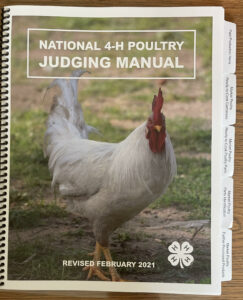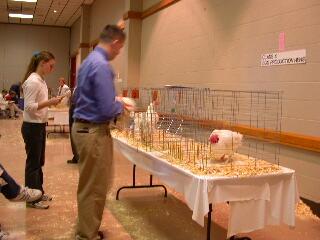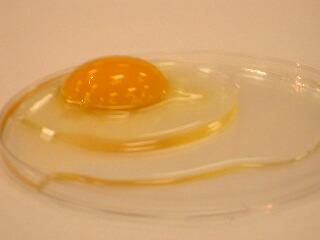4-H Poultry Judging
go.ncsu.edu/readext?67817
en Español / em Português
El inglés es el idioma de control de esta página. En la medida en que haya algún conflicto entre la traducción al inglés y la traducción, el inglés prevalece.
Al hacer clic en el enlace de traducción se activa un servicio de traducción gratuito para convertir la página al español. Al igual que con cualquier traducción por Internet, la conversión no es sensible al contexto y puede que no traduzca el texto en su significado original. NC State Extension no garantiza la exactitud del texto traducido. Por favor, tenga en cuenta que algunas aplicaciones y/o servicios pueden no funcionar como se espera cuando se traducen.
Português
Inglês é o idioma de controle desta página. Na medida que haja algum conflito entre o texto original em Inglês e a tradução, o Inglês prevalece.
Ao clicar no link de tradução, um serviço gratuito de tradução será ativado para converter a página para o Português. Como em qualquer tradução pela internet, a conversão não é sensivel ao contexto e pode não ocorrer a tradução para o significado orginal. O serviço de Extensão da Carolina do Norte (NC State Extension) não garante a exatidão do texto traduzido. Por favor, observe que algumas funções ou serviços podem não funcionar como esperado após a tradução.
English
English is the controlling language of this page. To the extent there is any conflict between the English text and the translation, English controls.
Clicking on the translation link activates a free translation service to convert the page to Spanish. As with any Internet translation, the conversion is not context-sensitive and may not translate the text to its original meaning. NC State Extension does not guarantee the accuracy of the translated text. Please note that some applications and/or services may not function as expected when translated.
Collapse ▲What is Poultry Judging?
4-H Poultry Judging is a 4-H Activity in which participants compete in teams or as individuals to demonstrate poultry judging mastery.
NC state-level 4-H Poultry Judging Contest
Registration is due Friday, June 21, 2024. This competition is for youth ages 8-18.
Registration is done through 4-H Online. See more information about NC 4-H on the NC 4-H Extension pages. Need to find your 4-H agent? Use this handy map with county links.
The date for the state-level 4-H Poultry Judging contest is Wednesday, July 10, 2024, starting at 10:00 a.m.
The location is Scott Hall (2711 Founders Drive, Raleigh 27695) but registration will take place at Bostian Hall Room 3712 (2721 Pillsbury Circle, Raleigh 27695) , which is located right behind Scott Hall.
What is Poultry Judging?
4-H Poultry Judging is a 4-H Activity in which participants compete in teams or as individuals to demonstrate poultry judging mastery.
Participants and Scoring
A poultry judging team has three or four members. The three highest scores from a team combine into a single team score.
The top North Carolina team represents the state at the National 4-H Poultry and Egg Conference.
ScoreSheet
Here is a downloadable version of the scoresheet.
Here is a link to the online fillable form. You will need to enter token number 44444h to access the form.
Divisions
There are three divisions in poultry judging. The North Carolina state-level contest has fifteen classes in the three divisions like the National contest.
- DIVISION I: Egg Production – Past Production Hens (11 pgs)
- DIVISION II: Market Poultry
- DIVISION III: Market eggs
4-H Poultry Judging Manual (Revised 2021)
The 61-page National 4-H Poultry Judging Manual covers what coaches and participants need to know about 4-H Poultry Judging Contests. The manual  was updated in 2021 with many colored images and details to assist in teaching 4-HPoultry Judging as well as the addition of two classes: Ready to Cook PartsGrading and Breaded Boneless Processed Poultry. The manual is the recommended reference for participants competing in the 4-H Annual Congress.
was updated in 2021 with many colored images and details to assist in teaching 4-HPoultry Judging as well as the addition of two classes: Ready to Cook PartsGrading and Breaded Boneless Processed Poultry. The manual is the recommended reference for participants competing in the 4-H Annual Congress.
The new manual is available online at no cost. Can also be ordered from NC State University.
State Contest Information
Eligibility
All youth must be registered members of a 4-H Club to participate.
Youth will compete as Junior (ages 8-13) or Senior (ages 14-18) participants.
Registration
Register by June 21, 2024. Registration opens on May 24, 2024. Register through 4-H Online, listed under 4-H Poultry Judging event.
Teams
Counties may register multiple Junior and/or Senior-level teams. Mixed-age-level teams are not allowed.
During the competition, teams are divided so that no two contestants from the same team will be in the same group. Groups remain together throughout the contest.
Individuals are allowed to compete who are not members of a team.
Winners
The first-place Senior team of the North Carolina 4-H Poultry Judging Contest is eligible to attend the National 4-H Poultry and Egg Conference.
Junior and Senior winning individuals or teams at the North Carolina 4-H Poultry Judging Contest may participate in subsequent state contests.
If the first-place Senior team attends the National 4-H Poultry and Egg Conference contest, they may participate in the next year’s state contest. However, they may not place first, second, or third.
The first-place Senior team attending the National 4-H Poultry and Egg Conference context may not return to the national contest in poultry judging. They may return if they participate and win any of the state 4-H Egg Cookery, Chicken Barbecue, or Turkey Barbecue Demonstration events.
Poultry Judging Division and Class Details
This section includes detailed descriptions of each poultry judging division and class.
The total possible score for all divisions and classes is 1,500 points.
- CLASSES TO BE JUDGED IN THE POULTRY JUDGING CONTEST
- Classes 1, 2, 3, 4, and 5 — Egg production and reasons – 500 points
 Classes 3 and 5 represent the Reasons portion of the contest, which is given for Classes 2 and 4, respectively. Three classes of four (4) Leghorns or Leghorn-type hybrids are to be judged on past production qualities. Hens may be handled. When evaluating live animals, the welfare of animals is important and should be considered. Being well-trained in handling hens is important to prevent discomfort or harm to them. In order to maintain the welfare of the hens, the procedure described in the manual should be adhered to. Anyone mishandling the hens will be given a single warning. If it continues, they will be eliminated from the contest. Contestants are not allowed to move or bend the hen’s pubic bones. The contestant can touch and place your fingers on each side of the pubic bones to determine thickness. But, you are not to try to move the pubic bones. The flexibility of the pubic bone is no longer to be considered a factor in placing the class. Contestants may NOT compare hens with others in their group. The hens should be placed in accordance with the contest rules as stated in the manual Contestants will give oral reasons for Classes 2 and 4. Using notes while giving reasons will NOT be permitted. A maximum of two minutes will be allowed for giving reasons for each class.
Classes 3 and 5 represent the Reasons portion of the contest, which is given for Classes 2 and 4, respectively. Three classes of four (4) Leghorns or Leghorn-type hybrids are to be judged on past production qualities. Hens may be handled. When evaluating live animals, the welfare of animals is important and should be considered. Being well-trained in handling hens is important to prevent discomfort or harm to them. In order to maintain the welfare of the hens, the procedure described in the manual should be adhered to. Anyone mishandling the hens will be given a single warning. If it continues, they will be eliminated from the contest. Contestants are not allowed to move or bend the hen’s pubic bones. The contestant can touch and place your fingers on each side of the pubic bones to determine thickness. But, you are not to try to move the pubic bones. The flexibility of the pubic bone is no longer to be considered a factor in placing the class. Contestants may NOT compare hens with others in their group. The hens should be placed in accordance with the contest rules as stated in the manual Contestants will give oral reasons for Classes 2 and 4. Using notes while giving reasons will NOT be permitted. A maximum of two minutes will be allowed for giving reasons for each class. - Classes 6, 7, 8, 9, and 10 — Grading ready-to-cook chicken carcasses and poultry parts, evaluation of further-processed poultry products, and identification of ready-to-cook poultry parts identification – 500 points
Classes 6 and 7 involve grading 10 RTC broiler and 10 RTC heavy broiler carcasses, respectively. Class 8 involves grading 10 RTC poultry parts and can be from a chicken or turkey carcass. Each individual carcass will be classified as A, B, C, or No grade. Carcasses will be displayed in such a way that the entire carcass can be observed. Parts will be placed in plastic baggies. Carcasses and parts may NOT be touched or handled. Pinfeathers, diminutive feathers, hairs, and discoloration are to be disregarded. Class 9 involves the evaluation of 10 further-processed poultry products for five possible factors. For each factor, contestants must indicate whether or not it is present. The further-processed products will be displayed on plates covered in plastic. The further-processed products may NOT be touched or handled. Class 10 is a class of ten (10) poultry parts. The parts may be from a chicken or turkey carcass. Each part is to be identified and the number of the part is written in the appropriate square in the front of the part name. The 10 parts will be selected from the 24 parts listed in the National 4-H Poultry Judging Manual. Each part will be prominently displayed on a baggie. The poultry parts may NOT be touched or handled. - Classes 11 and 12 — Market Eggs — Candled – 200 points
There will be two classes of 20 white-shelled chicken eggs to be candled for interior quality evaluation. Each egg is to be individually candled and classified as AA, A, B, or Loss. The Speed-King Candler will be used for candling eggs. Eggs MUST be handled. It is important to handle the eggs carefully. No shaking of the eggs is permitted. - Classes 13 and 14 — Exterior Egg Quality – 200 points
There will be two classes of 20 chicken eggs of any shell color to be individually classified AA/A, B, Dirty, or Loss. Eggs for exterior egg quality CANNOT be handled. - Class 15 — Broken-Out Market Eggs -100 points

One class of 10 eggs will be broken out on a flat surface. Each egg is to be classified as AA, A, B, or Inedible. Eggs and containers CANNOT be touched or handled. TOTAL PERFECT SCORE – 1,500 points
- Classes 1, 2, 3, 4, and 5 — Egg production and reasons – 500 points
- Scorecard for oral reasons on the egg production classes in the poultry judging contest.
- Appearance (general neatness) and delivery ——————————————– 24 points
- Did the contestant standstill, on both feet and face the judges?
- Did he/she speak clearly, distinctly, and loud enough to be heard without shouting?
- Did he/she have an appropriate opening and closing sentence?
- Did he/she speak smoothly and without long pauses?
- Did he/she have confidence; was he/she convincing?
- Proper use of terms —————————————————————————– 20 points
- Did the contestant mention such factors as pigment loss or bleaching, abdominal capacity, abdominal fat condition, and molt, or did he/she use terms that do not apply to judging egg production?
- Did he/she use the terms properly?
- Did he/she understand the terms used?
- Was he/she able to define the terms? (The contestant may be asked to define some terms).
- Accuracy of statement ———————————————————————- 20 points
- Did the contestant really see the hens?
- Were his/her statements true, partly true, or false?
- Completeness of coverage ——————————————————————– 36 points
- Did he/she actually tell why he/she placed one hen over another or did he/she just vaguely describe the hens? ———————————————————— (10)
- Did he/she stress the crucial differences between hens, or did he/she make stereotype comparisons of numerous factors? ———————————— (16)
- Did he/she tell all there was to tell of importance or were there several other good reasons that should have been given for his/her placing?——————– (10)
NOTE: The judges may ask the contestant to define one or two comparative terms.
- Appearance (general neatness) and delivery ——————————————– 24 points
DIVISION I: Egg Production – Hens
Perfect Score – 300 points
Classes 1 & 2 – Past Production Hens
You will judge eight (8) hens for past egg production qualities (4 hens in each class). The birds, that show the best production qualities, should be placed first, second, third, and fourth. This is comparison judging, and you must describe why the class was placed accordingly during your oral reasons. Pigment loss, handling qualities, and body capacity must be mentioned. Birds in this class must be handled. Contestants will give reasons on either Class 1 or 2. Each class is worth 100 points.
Class 3 – Oral Reasons
No notes are allowed while giving reasons. Ten (10) points will be deducted if notes are used. If contestants are not properly prepared or give inadequate reasons, they will be scored accordingly. Reasons class is worth 100 points.
DIVISION II: Market Poultry
Perfect Score – 200 points
Class 4 – Ready-to-Cook
RTC will be composed of ten (10) Ready-to-Cook broilers in the 2 to 6-pound category. All carcasses will be judged according to USDA standards and graded A, B or C quality.
Carcasses are not to be handled. Five (5) points will be deducted for each grade separation line crossed. Ten (10) points will be deducted if the contestant fails to enter a grade or if more than one grade is entered. The carcass class is worth 100 points.
Class 5 – Poultry Parts
This class will consist of ten (10) mixed poultry parts. Each contestant is to identify the parts by name. The parts cannot be handled. The parts are listed in the National Manual plus drummette and flat (these are in the new manual). Ten (10) points will be deducted for each incorrect answer. Parts class is worth 100 points.
DIVISION III: Eggs
Perfect Score – 500 points
Classes 6 & 7 – Exterior Eggs
This class will have 20 white eggs to be graded for exterior shell quality and graded A, B, or Dirty. One (1) point will be deducted if the A-B line is crossed and three (3) points deducted if the B-Dirty line is crossed. Four (4) points will be deducted if a contestant fails to enter a grade or if multiple grades are entered for an egg. The exterior egg class is worth 200 points.
Classes 8 & 9 – Interior Eggs
This class will have 20 white eggs to be judged for interior quality by candling them and grading them AA, A, B, or Inedible. One (1) point will be deducted for each grade separation line crossed except when the line between B and Inedible is crossed, then three (3) points will be deducted. Five (5) points will be deducted if a contestant fails to enter a grade or enters more than one grade for an egg.
Class 10 – Broken-Out Eggs
This class will have ten (10) broken-out eggs to be judged for interior quality and graded AA, A, B, or Inedible. Three (3) points will be deducted for each grade separation, except when the line between B and Inedible is crossed, then four (4) points will be deducted. Ten (10) points will be deducted if a contestant fails to enter a grade or enters multiple grades for an egg. Broken out class is worth 100 points.
For additional information contact
Dr. Mary Fosnaught
4-H & Youth Development Extension Associate
NC State Extension
Prestage Department of Poultry Science
Raleigh, NC 27695-7608
E-mail: mhfosnau@ncsu.edu
Phone: +1 919.515.5529
Dan Allen Map


